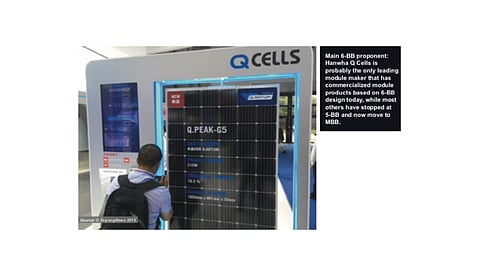

One of the most simple and straightforward ways to reduce resistance losses of solar cells is to add more busbars. Increasing the number of busbars reduces the gap between them, which also shortens the finger length. Thus, the current load carried by the section of fingers between the busbars lessens with a higher number of busbars. This decreases the internal electrical resistance of a solar cell to a great extent because the fingers have the highest impact on resistance losses.
While using 3-busbar cells was a standard in module assembly about 2 years ago, the industry has successfully shifted to 4-busbar cells in 2017. Now basically everyone has upgraded to 5-busbars modules and the latest product range of nearly every leading module maker features 5-busbar design. However, it is still a question, if the trend continues to 6 busbars. According to Fraunhofer ISE head of module design Martin Heinrich, there is certainly a benefit from moving to 6-busbar design. "But how much depends on the cell technology." Achim Kraft from ISE's module technology group gives an example: Heterojunction cells have a problem with grid reflectivity as they are formed with low temperature metallization. Thus, heterojunction cells have a higher gain when moving to a higher number of busbars compared to PERC cells.
Heinrich sees the 6-busbar design coming soon. In fact, Hanwha Q Cells was probably the first to announce such a product – they already presented a 6-busbar model already at SNEC 2018. REC, on the other hand, does not see the benefit of moving to 6 busbars. According to technology head Sridhara, an internal study showed that the gain of going from 4 to 5 busbars was quite significant. The power boost is about 2 W. However, moving from 5 to 6 busbars would have not merited the capex required for that transition at the cell and module level. This view was expressed by the several other module makers TaiyangNews talked to as well. The effort needed to move to more busbars lies in the upgrade possibility of the stringing machines of the module manufacturers. Most of the latest tools from leading stringing tools suppliers support the shift to 5 and often even 6 busbars (see TaiyangNews Market Survey on Cell Connection Equipment).
However, this mainly depends on the supplier and how recent the tool is. Moving to a higher number of busbars also increases the process complexity and ribbon consumption for module manufacturers. In the end, it is simply a cost of ownership question – and for many companies today's answer is to stop at 5 busbars for traditional cell interconnection designs. Looking at commercially available modules form leading suppliers, only Hanwha Q Cells is offering products based on 6 busbars (see table below).
According to ITRPV's 9th edition, the 3-BB approachhad a share of about 20% in 2017 and is expected to continuously decrease in the coming years to a negligible share by 2022 (see graph, p. 20). The 4-BB approach, which owned about 45% market share in 2017, is also anticipated to lose a few shares to 40% by the end of 2018, but is also destined to vanish within 10 years. On the other hand, 5-BB modules are expected to gain consistent market share – from close to 30% in 2017, to above 45% in 2017 and above 50% in 2020 at its peak. ITRPV believes 5-BB modules will retain its dominance in the long run, though its share is forecasted to fall to 40% by 2028. As for 6-busbars the roadmap optimistically anticipates that 6-busbar modules will reach a share of about 5% this year and more than 30% within 10 years. The busbar less (or multibusbar) cell approach is expected to expand its market share from less than 5% today, which seems optimistic, to 25% by 2028, which seems conservative.
The article was originally published in the TaiyangNews Advanced Module Technology Report 2018, which was released at Renewable Energy India Expo 2018 and can be downloaded for free here.
.png?w=50&fm=png)